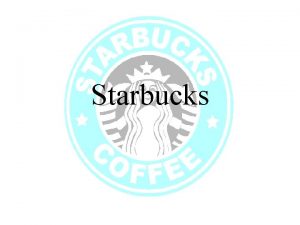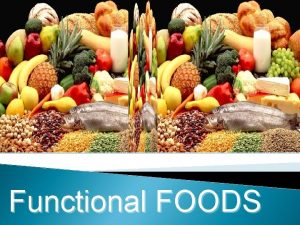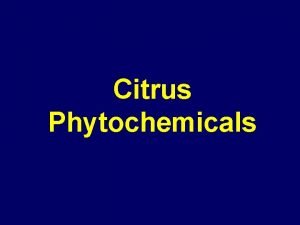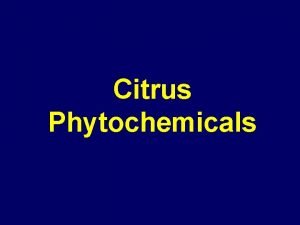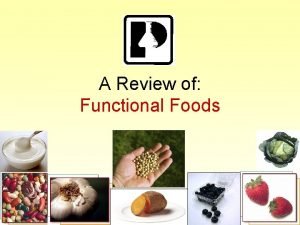CURRENT FUNCTIONAL FOODS TRENDS Luke R Howard Ph














































- Slides: 46

CURRENT FUNCTIONAL FOODS TRENDS Luke R. Howard, Ph. D. Department of Food Science University of Arkansas

Functional Foods “Any food or food ingredient that may provide a health benefit beyond the traditional nutrients it contains” The Institute of Medicines’s Food and Nutrition Board

Examples of Functional Foods * * Natural raw foods Genetically enhanced raw foods Fortified foods Dietary supplements

Top Ten Functional Foods Trends Elizabeth Sloan, President, Sloan Trends, Inc.

Key Trends in Functional Foods Products Digestive Health benefit/convenience Feel the benefit Energy “Superfruit” Antioxidants Weight management Healthy snacking Packaging innovation Bones and movement New Nutrition Business, 2012 Real food nutrition Mini-managers Bioavailability Protein power Plant-based diets Gourmet nutrition Risk awareness First aid Kids, Dads and Grandparents Liquidation Sloan, Food Tech. 2012, 4: 24 -41

Consumers Reporting Using Food to Prevent Specific Conditions % of Consumers ADHD Sensitivity to irritants Menopause difficulties Autoimmune disorders Hyperactivity Osteoporosis Memory/mind health High blood pressure Eating disorders Food allergy/sensitivity Heart or CVD Cancer Digestive disorders High cholesterol Overweight Diabetes Hartman group, 2010 18 20 21 22 24 27 28 41 42 42 42 46 48 56 57 58

Functional Foods are Booming Eight in 10 Americans are making some or a lot of effort to eat healthfully (FMI, 2011) 42% are concerned about the nutrient content of foods they buy (FMI, 2011) Sales of Functional foods and beverages were estimated at $38 billion in 2010 (NBJ, 2011) Self-treatment of minor ailments, and interest in alternative therapies is at an all time high (Packaged Facts, 2012)

Functional Foods are Booming 30% of consumers say they always or usually purchase grocery products labeled for improving specific health conditions (e. g. , heart, digestive, or blood sugar issues) (Packaged Facts, 2012) Young adults (18 -24 yrs) remain the top users of functional foods and beverages (Mintel, 2009) Oatmeal and yogurt are the products most frequently purchased for specific health benefits (Packaged Facts, 2012)

New Functional Food Products About 33% of the best selling products in 2010 -11 carried a natural claim (IRI, 2011) About 25% claimed added nutrients/nutrition, high fiber/whole grain, reduced calories or lowfat/fat-free contents (IRI, 2011) One in ten made a claim about energy, antioxidants, or trans fat (IRI, 2011)

1. Real Food Nutrition 88% of grocery shoppers believe it is important to get their nutrients from foods naturally rich in vitamins/minerals Health Focus, 2010) 32% of consumers are making a strong effort to eat more foods/drinks that are naturally rich in nutrients (MSI, 2010) 28% seek foods naturally rich in antioxidants (MSI, 2010) 28% look for fresh/minimally processed products (MSI, 2010)

1. Real Food Nutrition Orange and cranberry juice most popular beverages purchased for nutritional benefits (Packaged Facts 2012) Antioxidant-rich green tea is the most popular consumed tea in the U. S. (mintel, 2011) Strongest phytochemical mass market ingredients include polyphenols (anthocyanins, procyanidins), resveratrol, and carotenoids (Sloan 2012)

1. Real Food Nutrition 50% of shoppers bought dark chocolate, 47% almonds, 21% Greek yogurt, and 8% coconut water for their “Superfood” properties (FMI, 2011) Hot new “Superfoods” include; chick peas, lentils, nuts/seeds, cinnamon (FMI, 2011) Sales of organic food reached $23. 4 billion in 2010, 38% of consumers bought organic foods (NBJ, 2011) Sales of natural foods were $18 billion, 58% purchased pre-packaged foods marked all natural (NBJ, 2011)

1. Real Food Nutrition Clean labels are an important product label phrase (Hartman, 2010) No chemical additive label claims are important to 50% of shoppers, no preservatives are important to 35%, 50% look for natural ingredients on the ingredient listing (FMI, 2011) Consumers say limiting processed foods is now the third most component of healthy eating after eating more vegetables and fruits (Mintel, 2009)

Review of FDA Label Claims Natural – is not regulated, but the agency does not object to the use of the term if the food does not include added color, artificial flavors or synthetic substances Fresh – implies that the food is unprocessed, i. e. is in it’s raw state and has not been frozen or subjected to any form of thermal processing or any form of preservation

FDA Nutrient Health Claims “High”, “Rich-in”, or Excellent Source Of” Contains 20% or more of the DV per RACC “Good Source”, “Contains”, or “Provides” 10 -19% of the DV per RACC “More”, “Fortified”, “Enriched”, “Added”, “Extra”, or “Enriched” 10% of more of the DV per RACC “Antioxidant” • An RDI must be established for each of the nutrients that are the subject of the claim • Each nutrient must have existing scientific evidence of antioxidant activity • The level of each nutrient must be sufficient to meet the definition for “High”, “Good Source”, or “More”

FDA Nutrient Content Claims Nutrient Free Low Reduced/Less Calories Less than 5 cal per RACC and per labeled serving 40 cal or less per RACC At lease 25% fewer cal per RACC than an appropriate reference food Saturated fat Less than 0. 5 g saturated fat and trans fatty acids per RACC and per labeled serving 1 g or less per RACC and 15% or less of calories from saturated fat At lease 25% less saturated fat per RACC than an appropriate reference food Sugars Less than 0. 5 g sugars per RACC and per labeled serving Not define At lease 25% less sugars per RACC than an appropriate

FDA Health-Related Statements or Claims Nutrient content claims – indicate the presence of a specific nutrient at a certain level Structure and function – describe the effect of dietary components on the normal structure or function of the body Dietary guidance – describe the health benefits of broad categories of foods or diets and do not refer to a disease or a health related condition Qualified health claims – convey a developing relationship between components in a diet and reduced risk of disease, as reviewed by the FDA and supported by the weight of credible scientific evidence available Health claims – confirm a relationship between components in a diet and reduced risk of disease or health condition, as approved by FDA and supported by significant scientific agreement

Scientific Evidence is Lacking for Many Health Claims FDA has issued warning letters to many companies over various health claims and is now requiring pre-approval for certain claims FTC has recently settled class-action lawsuits with Dannon, Kellogg’s and Nestle over health claims

Strength of Evidence for Functional Foods Currently on the U. S. Market Functional food Bioactive compone nt Strengt h of evidenc e Recommende Regulatory d status amount Fortified Plant Reduce Clinical margarine sterol and total and trials s stanol LDL chol. esters Very Strong 1. 3 g/d for sterols, 1. 7 g/d for stanols Health claim Psyllium Soluble fiber Reduce Clinical total and trials LDL chol. Very strong 1 g/d Health claim Soy Protein Reduce Clinical total and trials LDL chol. Very strong 25 g/d Health claim Reduce Clinical total and trials LDL chol. Very strong 3 g/d Health claim Whole oat ß-glucan products Health benefit Type of evidenc e Hasler, J. Nutr. (2002) 132: 3772 -3781

Functional food Bioactive Health component benefit Type of evidence Strength of evidence Recommende d amount Regulatory status Cranberry juice Proanthocyanidins Reduce UTI Small # of clinical trails Moderate 300 m. L/d Conventional food Fatty fish (n-3) fatty acids Reduce TG, reduce hearth disease Clinical Strong trials, epidemiol. studies 2/wk Qualified health claim for dietary supplements Garlic Organosulfur compounds Reduce Clinical total and trials LDL chol. 600 -900 mg/d Conventional food or dietary supplement Green tea Catechins Reduce risk of various types of cancer Unknown Conventional food Moderate Epidemiol. Weak to studies moderate

Functional food Bioactive componen t Health benefit Type of evidence Strength of evidence Recommend ed amount Regulatory status Spinach, Lutein/ kale, collard zeaxanthin greens Reduce risk of AMD Epidemiol. Weak to moderate 6 mg/g Conventional food or dietary supplement Tomatoes and processed Lycopene Reduce risk of prostate cancer Epidemiol. Weak to moderate Daily Conventional food Cruciferous veg’s Glucosinolates, indoles Reduce risk of various types of cancer Epidemiol. Weak 3 or more Serv/wk Conventional food Fermented dairy Probiotics Support GI health, Boost immunity In vivo and Weak in vitro studies, limited clin. data Daily Conventional food or dietary supplement

Dietary Supplement Label “This statement has not been evaluated by the FDA. This product is not intended to diagnose, treat, cure, or prevent any disease” Structure/function claim Manufacturer is responsible for ensuring the accuracy and truthfulness of these claims – not approved by FDA

2. Mini-Managers 58% of shoppers swapped for healthier versions of the same foods half the time (FMI, 2010) 56% switched to whole-grain bread, 42% to whole grain pasta, and 39% to whole grain rice (FMI, 2011) 52% replace less healthy choices with different foods 46% purchase new health products (FMI, 2010) Largest avoidance market included low-fat/fat-free ($46 billion), reduced calorie ($10. 4 billion) and low sodium/low salt ($10. 0 billion) (Nielson, 2011)

2. Mini-Managers Foods consumers try to avoid (FMI, 2011) Trans and saturated fats – 59% Fat content – 56% Salt/sodium – 52% Calories – 48% Chemical additives – 47% Artificial sweeteners – 47% High fructose corn syrup – 44% Cholesterol – 43% Sugar – 42%

2. Mini-Managers Consumers are snacking more on healthier items (Technomic, 2012) ü Trail mixes ü Natural and organic snacks – no trans fat and antioxidant-rich ü 67% of consumers eat granola, cereal or breakfast bars, while only 28% are users of energy/diet/nutrition bars

2. Mini-Managers Energy Bar Use (Mintel, 2012) ü Snacks – 59% ü Overall wellness – 50% ü Meal replacement – 35% ü Protein – 35% ü Lose weight – 27% ü Muscle recovery – 25% ü Enhance metabolism – 23% ü Control blood sugar – 16%

3. Buying in to Bioavailability More than 25% of the best selling foods in 2010 -11 carried an added vitamin/nutrient claim (IRI, 2011) About half of food shoppers are very concerned about the nutrient content of their food (FMI, 2011) Vitamin/mineral health claims on labels are very important to 37% of grocery shoppers (FMI, 2011)

3. Buying in to Bioavailability Consumers believe: (FMI, 2011) ü Calcium is effective for bone health – 55% ü Omega-3 s are effective for heart health (38%), skin (25%) and brain health (23%) ü Fiber is important for colon health (50%) and weight loss (28%) ü Over half of consumers say building bone density is an important consideration when buying food

3. Buying in to Bioavailability 55% of consumers would like more clinical proof surrounding the bioavailability of nutrients in fortified foods (French, 2011) 42% are concerned that their body does not absorb enough of the nutrients in supplements (French, 2011) Magnesium is the fastest growing mineral supplement in the U. S. , and is the third most popular ingredient in hearth-healthy foods/drinks (NBJ, 2011) Look for new foods containing magnesium, vitamin D and calcium aimed at bone

4. Protein Power 40% of consumers are making an effort to eat more protein and say a high protein claim is very important on a food label (IFIC, 2011; FMI, 2011) Consumers rank protein as the fifth most important component of healthy eating (Mintel, 2009) 65% of adults believe that protein helps build muscle, 39% say that it helps you feel full, 39% believe it is beneficial for aging, and 34% believe that it aids with weight loss (IFIC,

4. Protein Power 69% of those trying to lose weight are trying to consume more foods/beverages that promote satiety (MSI, 2010) 53% of adults want more satiating functional foods, and 44% seek functional beverages that offer satiety (Mintel, 2009, MSI, 2010) Expect high-protein sports nutrition powders/drinks to move mainstream

5. Plant-Based Diets Consumers recognize vegetables, fruits, pulses, whole-grain breads and beans as naturally-rich foods (MSI, 2010) 45% of consumers bought foods/beverages that were labeled high in fiber (Packaged Facts, 2012) According to American Culinary Federation chefs, ancient grains, flatbreads, whole-grain bread/rolls and vegetable chips are hot foods/ingredients for 2012 (NRA, 2011)

5. Plant Based Diets 60% of meal preparers are making a strong effort to include more fruits and vegetables at dinner, 42% are attempting to include more whole grains (MSI, 2011) A serving of fruit/vegetables is a very important claim for 67% of consumers (Health Focus, 2010) ACF chefs cite acai, goji berry and mangosteen as hot superfruits for 2012, with rambutan, dragon fruit, paw, guava and passion fruit identifies as favored exotic species (NRA, 2011)

New Superfruits? Acai Goji berry Rambutan Paw paw Mangosteen Dragon fruit Guava Passion fruit

5. Plant Based Diets Trendy produce items for 2012 include; specialty potatoes, fresh herbs, dark bitter vegetables, root vegetables, fresh bean and hot pepper varietals, Asian mushrooms, soybeans, vegetable ceviche, and wasabi peas (NRA, 2011) ACF chefs cited vegetable/vegetarian as the number one hot appetizer trend for 2012 (NRA, 2011)

5. Plant Based Diets ü ü Research continues to show potential functional value of plant-based superfoods Almonds – contain phytosterols, aid satiety and help stabilize glucose levels Pistachios – may lower cholesterol Walnuts- are linked to brain health & cancer prevention Beans – may lower the risk of cognitive deficits IFT, 20012

6. Gourmet Nutrition 50% of consumers believe that healthy food should taste good (French, 2011) Seven in 10 consumers believe that food described as fresh is healthier (Technomic, 2010) 68% look for freshness descriptors when purchasing foods (Technomic, 2010)

6. Gourmet Nutrition ü ü ü Look for the following trends Frozen meals will be replaced with fresh less processed alternatives Growth in breakfast foods Healthy kids meals Smaller versions of adult meals Greater availability of locally grown foods Reduced sodium entrees Hartman, 2010; NPD, 2011; NRA, 2011; IDDBA, 2011; NRA, 2011

7. Risk Awareness on the Rise ü The market for heart-healthy products is shifting from general heart health to risk factor reduction (FMI, 2011) Concern over heart disease risk factors is growing among younger adults (Hartman, 2010) 66% of boomers are concerned about high blood pressure, 48% of Gen X and 40% of Gen Y consumers are concerned about cholesterol (Hartman, 2010)

7. Risk Awareness on the Rise Look for more foods that improve circulation/heart health Cocoa. Via – flavanol-rich supplement Also look for more products that improve mental acuity/brain health/mental sharpness (Health Focus, 2010) High blood glucose is the fourth-largest cause of preventable death in America-behind only smoking, obesity, and high blood pressure (Danaei et al. , 2009) Look for foods designed to improve insulin resistance, and control and manage blood sugar (Sloan, 2012)

8. First Aid Natural remedies to prevent/treat common everyday aches and ailments Young Gen Yers are the most likely to believe that functional foods/beverages can be used in place of some medicines (French, 2011) Look for foods that improve digestive health, boost the immune system, improve joint health, and reduce stress (Hartman, 2010; Health Focus, 2010)

9. Kids, Dads and Grandparents Only 40% of kids food/beverage market was positioned as better-for-you in 2010 (Packaged Facts, 2011) One in eight children have two or more risk factors for heart disease; one in three is overweight or obese (NCHS, 2010) 37% of men are very concerned about nutrition (MSI, 2010) 60% are making a strong effort to limit fats, 54% salt-sodium reduction, 49% sugar, and 44% cholesterol (MSI, 2010)

9. Kids, Dads and Grandparents One third of the U. S. population is now over age 55 (Packaged Facts, 2011) Important issues to those 50+ include: retaining mental sharpness, avoiding heart disease, preventing cancer, bone health/strength, maintaining the ability to continue with normal activity as they age and preserving eye health (Health Focus, 2010)

10. Liquidation Weight control/nutrition liquids and powders and energy drinks sales increased by 18%, followed by sports drinks (up 11%) ((IRI, 2012) Energy/alertness, gut health, heart health, immunity, sports/recovery and weight control were the top claims on new U. S. functional beverages in 2011(Innova, 2011) Calcium, antioxidants, and vitamins/minerals are the top ingredients consumers look for in functional beverages (Mintel, 2010)

10. Liquidation Immunity, digestive health, complete days nutrition requirement, lowering cholesterol, and providing energy are the most desired health benefits for functional beverages (Mintel, 2010) Look for new technologies e. g. high pressure pasteurization and caps that dispense sensitive ingredients at the time of consumption) to gain in popularity (Sloan , 2012)

Conclusions There is a disconnect between what consumers say and do! Few health claims have been substantiated for phytochemical-rich foods! Health-protective effects in in vitro and animal studies often do not translate to humans Well defined clinical trials are needed to substantiate health benefits observed in in vitro and animal studies Consumers must understand that functional foods are not a “magic bullet” or panacea for poor health habits
 Functional food wikipedia
Functional food wikipedia Current trends in athletic training
Current trends in athletic training Lystya
Lystya Current trends in medical education
Current trends in medical education Current trends in music
Current trends in music Current trends in counseling
Current trends in counseling Recent trends in project management
Recent trends in project management 5 trends in media and information
5 trends in media and information Emerging trends in strategic management
Emerging trends in strategic management Non functional plasma enzyme example
Non functional plasma enzyme example Plasma enzyme
Plasma enzyme Functional and non functional
Functional and non functional Band and loop space maintainer advantages
Band and loop space maintainer advantages Line currents
Line currents Non planar circuit
Non planar circuit Ceramic composition resistors
Ceramic composition resistors Drift current density unit
Drift current density unit Drift current and diffusion current
Drift current and diffusion current Power formula three phase
Power formula three phase A jfet always operates with
A jfet always operates with Chapter 3 shielded metal arc equipment setup and operation
Chapter 3 shielded metal arc equipment setup and operation Ac theory 3 lesson 4
Ac theory 3 lesson 4 Line currents
Line currents Touch current vs leakage current
Touch current vs leakage current Drift current
Drift current Slideplayer
Slideplayer Intelligenz gardner
Intelligenz gardner Howard hughes philanthropy
Howard hughes philanthropy Howard h stevenson
Howard h stevenson Peter g schultz
Peter g schultz Howard eales
Howard eales Nicosia 1966
Nicosia 1966 Dr howard zhang
Dr howard zhang Howard learner
Howard learner All in the valley of death rode the 600
All in the valley of death rode the 600 Howard padwa
Howard padwa Howard
Howard Minnie howard high school
Minnie howard high school Starbucks logos over time
Starbucks logos over time Accommodation theory howard giles
Accommodation theory howard giles Howard
Howard Transformational leadership four i's
Transformational leadership four i's Howard fields
Howard fields 3 progressive presidents
3 progressive presidents Howard university cancer center
Howard university cancer center Howard county kindergarten
Howard county kindergarten Parc du domaine howard
Parc du domaine howard






































